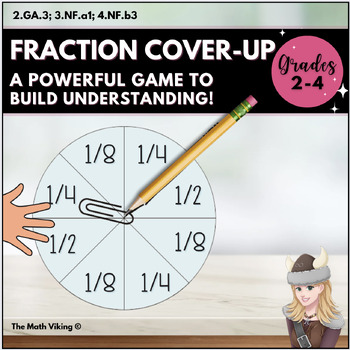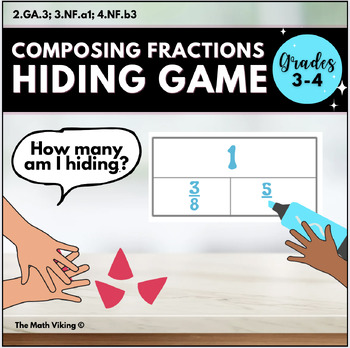Fraction Games Hands On BUNDLE: Cover Up, Hiding Fractions, Battle Royale FUN
Math Viking
2.5k Followers
Grade Levels
2nd - 5th
Subjects
Resource Type
Standards
CCSS3.NF.A.1
CCSS3.NF.A.3
CCSS3.NF.A.3b
CCSS3.NF.A.3c
CCSS3.NF.A.3d
Formats Included
- Zip
Pages
75 pages
Math Viking
2.5k Followers
Products in this Bundle (4)
Bonus
Which One Doesn't Belong? Zentangle Coloring Page: Fraction Sample WODB
Description
This amazing bundle offers the most engaging fraction games, that REALLY drive home the BIG IDEAS! From the most basic introduction at a second grade level, to challenging Battle Royale games, these serve as engaging lesson openers and the most worthy center activities! (Visit the Math Viking blog for FREE fraction resources)
Appropriate for Grades 3-5. Hiding Fractions is a fabulous game for emerging learners and interventions. Fraction cover up has many levels of play and Battle Royale is... AN EPIC JOURNEY of fraction understanding! :D
See individual products for details. These games are ALL YOU NEED for hands-on fun and making connections. Includes fraction cards to play simple games like Fraction War and Least to Greatest as well.
Total Pages
75 pages
Answer Key
N/A
Teaching Duration
N/A
Report this resource to TPT
Reported resources will be reviewed by our team. Report this resource to let us know if this resource violates TPT’s content guidelines.
Standards
to see state-specific standards (only available in the US).
CCSS3.NF.A.1
Understand a fraction 1/𝘣 as the quantity formed by 1 part when a whole is partitioned into 𝘣 equal parts; understand a fraction 𝘢/𝑏 as the quantity formed by 𝘢 parts of size 1/𝘣.
CCSS3.NF.A.3
Explain equivalence of fractions in special cases, and compare fractions by reasoning about their size.
CCSS3.NF.A.3b
Recognize and generate simple equivalent fractions, (e.g., 1/2 = 2/4, 4/6 = 2/3). Explain why the fractions are equivalent, e.g., by using a visual fraction model.
CCSS3.NF.A.3c
Express whole numbers as fractions, and recognize fractions that are equivalent to whole numbers. Examples: Express 3 in the form 3 = 3/1; recognize that 6/1 = 6; locate 4/4 and 1 at the same point of a number line diagram.
CCSS3.NF.A.3d
Compare two fractions with the same numerator or the same denominator by reasoning about their size. Recognize that comparisons are valid only when the two fractions refer to the same whole. Record the results of comparisons with the symbols >, =, or <, and justify the conclusions, e.g., by using a visual fraction model.





